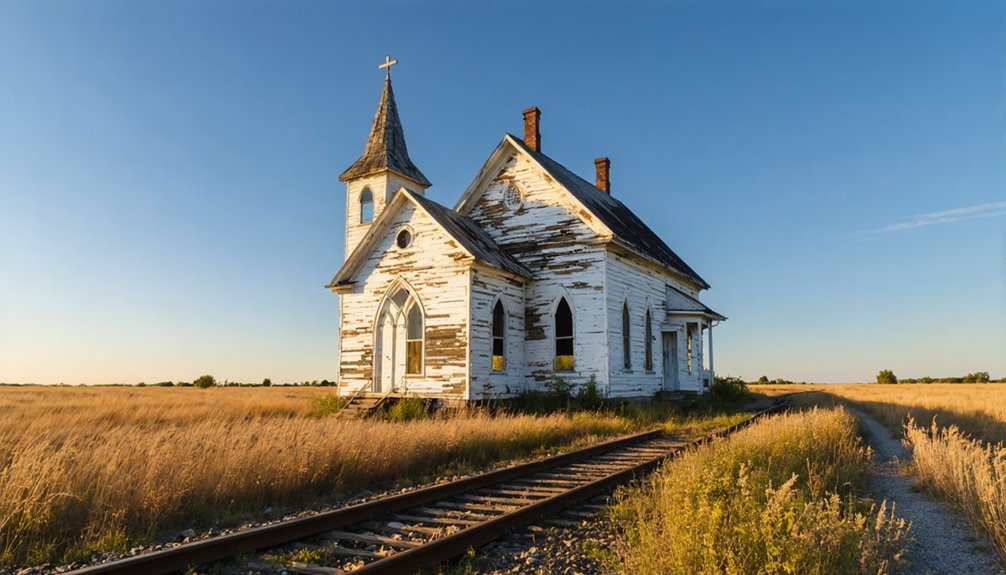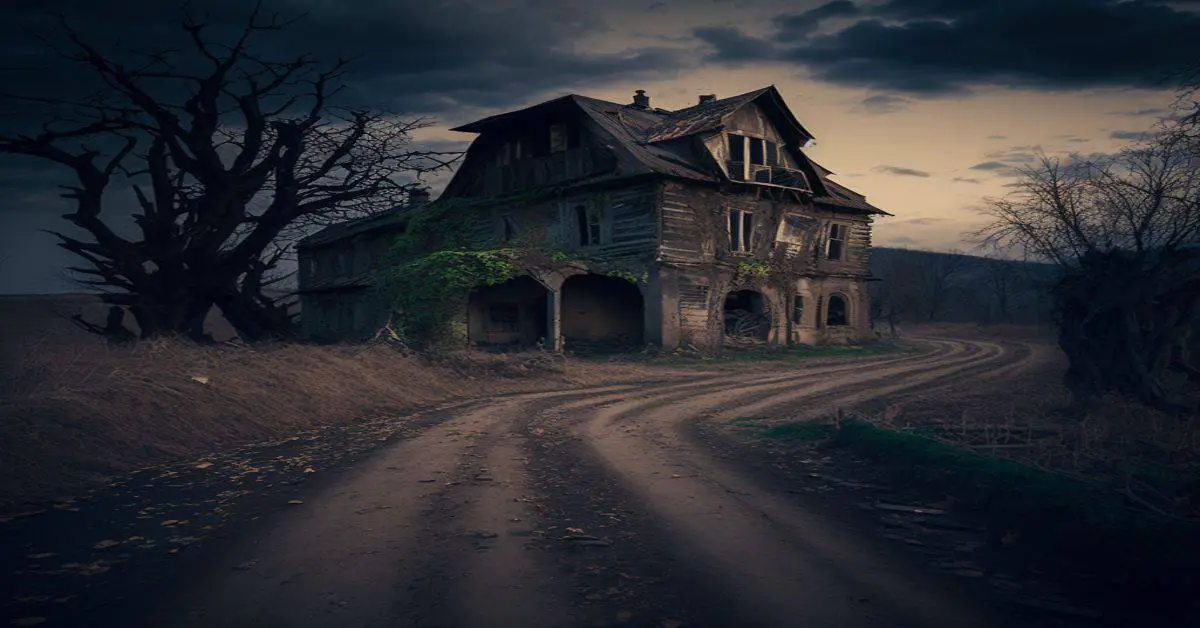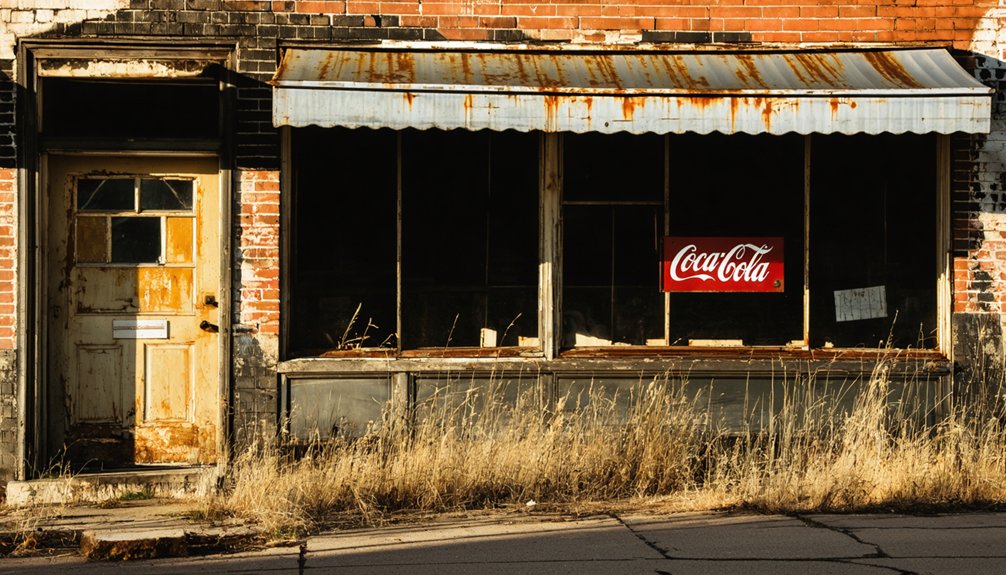You’ll find Rodden as an unincorporated ghost town in Jo Daviess County, Illinois, along U.S. Route 20 at Rodden Road. This former settlement thrived around its general store and post office in the mid-1800s, serving as both marketplace and community hub. The railroad’s arrival brought prosperity through agricultural trade, processing 240 gallons of milk daily by the 1890s. Today, scattered foundations and the historic Inn at Irish Hollow preserve traces of this once-bustling community’s fascinating story.
Key Takeaways
- Rodden is an unincorporated ghost town in Elizabeth Township, Jo Daviess County, Illinois, located near U.S. Route 20.
- Few original structures remain today, with only scattered foundations and the historic general store building still standing.
- The town declined after its railroad importance diminished, though it once processed 240 gallons of milk daily in the 1890s.
- The former general store and post office has been preserved as part of the Inn at Irish Hollow.
- Local historical societies maintain records and artifacts of Rodden, making it a destination for ghost town enthusiasts.
Origins and Early Settlement Days
While many northern Illinois settlements emerged along major migration routes in the early 1800s, Rodden took root as an unincorporated community in Elizabeth Township, Jo Daviess County.
You’ll find it positioned near U.S. Route 20, where Rodden Road intersects, at roughly 42.32806°N latitude and 90.32028°W longitude.
Early settler experiences shaped the community’s character as pioneers from Ohio, Massachusetts, and New York established homesteads near transportation routes. Like the ghost town of Ostend, the area attracted early homesteaders seeking new opportunities.
Similar to the Chicago Burlington and Quincy Railroad’s influence on Buda’s establishment in 1854, these settlers brought their agricultural practices and community customs to the wilderness, transforming it into farmland after 1824.
They developed the area around stagecoach trails, creating economic and social connections with neighboring towns like Galena and Elizabeth.
A general store and post office became central to daily life, with the store later partially becoming the Inn at Irish Hollow.
Life Around the General Store
The heart of Rodden’s community life centered around its bustling general store, which stood as both marketplace and meeting place from the mid-1800s through the early 1900s.
You’d find locals gathering daily to exchange news, trade goods, and conduct business. The store offered everything from basic provisions to specialized tools, while also housing the town’s post office. Like the old schoolhouse in Coltonville, the general store remains as a testament to the town’s vibrant past.
Store interactions went far beyond simple transactions. You could barter your farm goods for store credit or catch up on the latest news from neighboring towns. Similar to the successful towns of Canton and Lewistown, Rodden’s general store helped sustain the community through changing times.
During community gatherings, the store served as a natural hub where you’d meet travelers passing through, share stories, and participate in local decision-making.
The store owner played a vital role in maintaining the social fabric, often extending credit to help neighbors through tough times.
The Railroad’s Impact and Decline
As trains first rumbled through Rodden in the mid-1800s, this small Illinois settlement quickly transformed into an essential railroad stop serving local families and agricultural trade.
You’d have seen bustling rail yards, stations, and bridges that connected the community to major urban centers.
Yet railroad safety remained a constant concern. The tragic death of fireman Bernard R. Donnelly in a bridge collapse over the Apple River highlighted the dangerous nature of early rail operations.
Similar to the Alton & Sangamon railroad routes, earthen embankments still rise from the surrounding fields as silent testaments to Rodden’s railroad past.
Infrastructure challenges, including maintenance issues and accidents, disrupted services and eventually contributed to the line’s decline.
The station processed and transported approximately 240 gallons of milk daily during the late 1890s, serving as a vital hub for local dairy farmers.
Hidden Treasures of Irish Hollow
Beyond the abandoned railroad tracks and fading memories of Rodden lies Irish Hollow, a treasure trove of historical artifacts and untold riches waiting to be discovered.
You’ll find 500 acres of pristine wilderness surrounding the Inn at Irish Hollow, where treasure hunting enthusiasts search for remnants of the past. The area’s connection to Native American settlements, mining operations, and outlaw legends suggests potential discoveries beneath the surface. Some believe Harvey John Bailey’s millions may be hidden in the area’s dense woodlands. Any Native American artifacts discovered on public lands are protected by law.
Before you grab your metal detector, remember that responsible exploration is essential. You’ll need proper permissions to explore private lands, and it’s wise to consult local archaeological authorities about your finds.
The nearby Winfield Mounds and DuPage Forest Preserves have already yielded significant historical artifacts, proving that patient searchers who respect preservation guidelines often uncover the most remarkable treasures.
Natural Beauty and Scenic Routes
You’ll find some of Illinois’s most striking vantage points along the hidden valleys surrounding Rodden, where rolling agricultural fields meet patches of native prairie and hardwood forest.
The region’s proximity to the Driftless Area provides elevated overlooks where you can spot wildlife like white-tailed deer and migratory birds against a backdrop of seasonal wildflowers and fall foliage. Along these routes, visitors can enjoy diverse wetland prairies reminiscent of the Illinois River Road National Scenic Byway.
From the rural backroads, you’ll encounter a mix of gravel and dirt paths that wind through this varied terrain, offering year-round access to scenic spots though conditions are best during drier months. Visitors are strongly encouraged to plan trips during winter months to avoid encounters with snakes that are active in warmer weather.
Hidden Valley Overlooks
Hidden Valley offers visitors a network of tranquil hiking trails through Lockport’s lush natural landscapes, while Greene Valley Forest Preserve provides more dramatic elevated views from its 190-foot scenic overlook.
At Greene Valley, you’ll find panoramic views stretching across forest preserves to the Chicago skyline, accessible via the 2.6-mile Hawk Trail loop.
While Hidden Valley’s trails focus on peaceful woodland exploration, Greene Valley showcases over 500 native plant species and 370 native animals across its 1,388 acres.
You’ll discover diverse ecosystems along 12 miles of marked trails, with amenities like seasonal restrooms and picnic areas at the overlook.
The preserve welcomes leashed dogs and cyclists, making it an ideal destination for outdoor enthusiasts seeking both scenic views and recreational opportunities in the Chicago suburbs.
Rural Backroad Adventures
While traversing the rural backroads near Rodden, visitors can explore a network of scenic routes that branch from U.S. Route 20.
These winding paths offer perfect opportunities for backroad exploration and rural cycling through Jo Daviess County’s pastoral landscapes. You’ll discover remnants of old settlements, historic farmsteads, and peaceful countryside vistas along the way.
- Low-traffic gravel roads ideal for cycling adventures and leisurely drives
- Seasonal highlights including autumn foliage and spring wildflowers
- Wildlife viewing opportunities with frequent deer and bird sightings
- Dark skies perfect for stargazing and night photography
- Access to hidden spots like abandoned homesteads and rural cemeteries
Pack your map and camera, as cell service can be spotty.
The roads are often unpaved, so choose your vehicle accordingly and watch for weather conditions that might affect road quality.
Modern Legacy and Preservation
While you’ll find few intact structures in Rodden today, scattered foundations and the historic Rodden Road intersection with U.S. Route 20 serve as tangible reminders of this former settlement.
The town’s memory persists through local historical societies and family genealogies, creating an informal network of preserved stories and documented experiences.
Ghost town enthusiasts and history buffs continue to visit the area, photographing remnants and sharing discoveries online, though the site lacks formal tourist facilities or interpretive centers.
Architectural Heritage Still Standing
Although Rodden has faded into ghost town status, several significant architectural structures remain as evidence to its historical legacy.
You’ll find examples of early Midwest rural architectural styles throughout the area, from simple frame buildings to more substantial commercial structures. The adaptive reuse of the former Rodden general store, now the Inn at Irish Hollow, preserves the town’s historic character while giving it new purpose.
- Rodden Road intersects with U.S. Route 20, maintaining original town infrastructure
- The Inn at Irish Hollow incorporates the historic general store and post office
- Several original residences and farms from the town’s operational period
- The Winston Tunnel stands as a monument to 19th-century engineering
- Early 20th-century commercial buildings with period features like large storefront windows
Community Memory Lives On
Beyond the physical remnants of Rodden’s architecture, the town’s legacy thrives through active community engagement and preservation efforts.
You’ll find local residents gathering regularly to share oral histories, while historical societies collaborate to preserve essential documents and artifacts from Rodden’s past.
Universities conduct archaeological surveys, and schools integrate the ghost town’s history into their curricula.
The Inn at Irish Hollow maintains part of Rodden’s old general store, offering a tangible connection to the past.
Through social media groups, blogs, and podcasts, enthusiasts keep Rodden’s stories alive, while historical markers and interpretive signs help visitors understand the town’s significance.
Despite challenges in funding and preservation, the community’s dedication guarantees that Rodden’s cultural heritage endures through both physical landmarks and shared memories.
Tourism Meets Local History
Today’s visitors to Rodden encounter a thoughtful blend of historical preservation and modern tourism infrastructure.
You’ll find historical markers and repurposed buildings like the Inn at Irish Hollow, which breathes new life into the old general store. The ghost town tourism experience integrates seamlessly with nearby attractions like Eagle Ridge Resort and the historic city of Galena.
- Explore weathered structures and interpretive signage at your own pace
- Photograph untouched rural landscapes and natural preserves
- Visit the Winston Tunnel and other physical remnants of local heritage
- Connect with authentic historical sites rather than commercialized attractions
- Participate in seasonal community events that keep Rodden’s story alive
The town’s quiet ambiance and preserved structures offer you a genuine glimpse into Illinois’ past, while nearby amenities guarantee a comfortable visit to this off-the-beaten-path destination.
Frequently Asked Questions
Are There Any Reported Paranormal Activities in Rodden’s Abandoned Structures?
Like a whisper lost in wind, you won’t find documented ghost sightings in Rodden’s structures, though nearby haunted locations suggest regional paranormal activity exists throughout abandoned Illinois towns.
What Was the Population of Rodden During Its Peak Years?
You won’t find documented population records for Rodden’s peak years, but based on similar Illinois ghost towns and the community’s limited infrastructure, it likely never exceeded a few hundred residents.
How Did the Town Get Its Name “Rodden”?
Like many 19th-century Illinois towns, you’ll find Rodden’s name comes from early settlers or prominent local families. Historical town naming practices in Jo Daviess County typically preserved the legacy of influential landowners.
Are Metal Detecting and Artifact Hunting Allowed in Rodden?
You’ll need specific permits for metal detecting, as strict artifact preservation regulations protect historic sites. It’s prohibited on public lands without authorization and requires private landowner permission where applicable.
What Native American Tribes Originally Inhabited the Rodden Area?
Like ancient footprints in time, you’ll find the Illiniwek Confederation’s tribes, particularly the Cahokia, Peoria, and Kaskaskia, were the primary Native tribes who called this land home before European settlement.
References
- https://www.tripadvisor.com/Attraction_Review-g28945-d10045204-Reviews-Rodney_Ghost_Town-Mississippi.html
- https://www.youtube.com/watch?v=fy3yJDBA5nI
- https://en.wikipedia.org/wiki/Rodden
- https://drloihjournal.blogspot.com/p/lost-towns-of-illinois-series.html
- https://www.youtube.com/watch?v=Y8aD_M62HKA
- https://en.wikipedia.org/wiki/List_of_ghost_towns_in_Illinois
- https://www.youtube.com/watch?v=gM3ZIgtFzBk
- https://northwestchicagoland.northwestquarterly.com/2023/09/27/ghost-towns-of-the-old-northwest/
- https://www.heraldtimesonline.com/story/lifestyle/home-garden/2021/01/15/some-illinois-ghost-towns/43846097/
- http://sites.rootsweb.com/~ilcoletp/history/history_of/history_of_coles_county.htm



